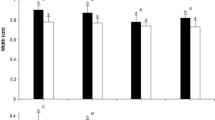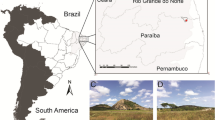Abstract
The buffy-headed marmoset (Callithrix flaviceps) is apparently the only predispersal herbivore of the seeds of Siparuna guianensis at the Caratinga Biological Station in southeastern Brazil. Both the fruit receptacles and the frutioles (seeds) of S. guianensis are relatively rich in nutrients such as carbohydrates, proteins, and lipids, but the receptacles contain high concentrations of benzylisoquinoline alkaloids. The latter presumably act as a qualitative chemical defense, impeding the access of potential predators to the alkaloid-poor frutioles. However, on ripening, the receptacle splits open, exposing the frutioles, which enables C. flaviceps to avoid the plant's chemical defenses effectively. Taking care to avoid contact with the receptacle, the marmosets pluck out the frutioles and ingest the seeds. Qualitative and quantitative changes (in particular a significant reduction in daily ranging) in the marmosets' behavior during the period when S. guianensis frutioles were accessible indicate that this was a preferred plant resource. This is the first record of the consumption of S. guianensis seeds by callitrichine monkeys (which are not known to be systematic seed eaters), despite the fact that both are widely distributed in the Neotropics. It is thus possible that the behavioral strategy observed here is a unique phenomenon resulting from a specific combination of factors, including the abundance of S. guianensis within the study area. The lack of other records may nevertheless be a result of insufficient sampling effort, in which case, the feeding strategies of callitrichines may have an important influence on the reproductive biology of S. guianensis in many areas.
Similar content being viewed by others
REFERENCES
COIMBRA-FILHO, A. F., and MITTERMEIER, R. A. 1976. Exudate eating and tree-gouging in marmosets. Nature 262:630.
CORRéA, H. K. M. 1995. Ecologia e comportamento alimentar de um grupo de saguis-da-serraescuros (Callithrix aurita E Geoffroyi 1812) no Parque Estadual da Serra do Mar, Núcleo Cunha, São Paulo, Brasil. Unpublished MSc dissertation. Universidade Federal de Minas Gerais, Minas Gerais, Brazil.
DIGBY, L. J., and BARRETO, C. E. 1998. Vertebrate predation in common marmosets. Neotrop. Primates 6:124-126.
DUKE, J. A. 1962. Monimiaceae, p. 230, in R. E. Woodson Jr. and R. W. Schery (eds.). Annals of the Missouri Botanical Garden, XLIX(3/4), Flora of Panama, Part IV.
FERRARI, S. F. 1991. Preliminary report on a field study of Callithrix flaviceps, pp. 159-171, in A. B. Rylands and A. T. Bernardes (eds.). A Primatologia no Brasil-3. Sociedade Brasileira de Primatologia, Belo Horizonte.
FERRARI, S. F. 1993. Ecological differentiation in the Callitrichidae, pp. 314-328, in A. B. Rylands (ed.). Marmosets and Tamarins: Systematics, Ecology and Behaviour. Oxford University Press, Oxford.
FERRARI, S. F., and MARTINS, E. S. 1992. Gummivory and gut morphology in two sympatric callitrichids (Callithrix emiliae and Saguinus fuscicollis weddelli) from western Brazilian Amazonia. Am. J. Phys. Anthropol. 88:97-103.
FERRARI, S. F., and RYLANDS, A. B. 1994. Activity budgets and differential visibility in field studies of three marmosets (Callithrix spp.). Folia Primatol. 63:78-83.
FERRARI, S. F., CORRÊA, H. K. M., and COUTINHO, P. E. G. 1996. Ecology of the “southern” marmosets (Callithrix aurita and Callithrix flaviceps): How different, how similar? pp. 157-171, in M. A. Norconk, A. L. Rosenberger, and P. A. Garber (eds.). Adaptive Radiations of Neotropical Primates. Plenum Press, New York.
GOLDIZEN, A. W., TERBORGH, J., CORNEJO, F., PORRAS, D. T., and EVANS, R. 1988. Seasonal food shortage, weight loss, and the timing of births in saddle-back tamarins (Saguinus fuscicollis). J. Anim. Ecol. 57:893-901.
GUINAUDEAU, H., LEBOEUF, M., and CAVé, A. 1988. Aporphinoid alkaloids. J. Nat. Prod. 51:389-474.
HARBORNE, J. B. 1991. The chemical basis of plant defense, p. 46, in R. T. Palo and C. T. Robbins (eds.). Plant Defenses Against Mammalian Herbivory. CRC Press, Boca Raton, Florida.
HARBORNE, J. B., and TURNER, B. L. 1984. Plant Chemosystematics. Oxford, Oxford University Press, p. 75.
HERSHKOVITZ, P. 1977. Living New World monkeys (Platyrrhini), with an Introduction to Primates, Volume 1. Chicago University Press, Chicago.
HOROWITZ, W., CHICHILO, P., and REYNOLDS, H. 1984. Official Methods of Analyses. 14th ed. Association of Official Analytical Chemists, p. 988. Virginia.
JONES, D. B. 1941. Factors for converting percentages of nitrogen in foods and feeds into percentage of protein, 22nd ed. Circ. 183. United States Department of Agriculture, Washington, D.C.
KAWAMURA, S. 1965. Sub-culture among Japanese macaques. In K. Imanishi, and S. A. Altmann (eds.). Monkeys and Apes: Sociological Studies. Emory University Press, Atlanta, Georgia.
KELLER, R. S., and MILNE, F. W. 1974. EPA/NIH Mass Spectra Data Base, Government Printing Office, Washington, D.C.
KINZEY, W. G., and NORCONK, M. A. 1993. Physical and chemical properties of fruit and seeds eaten by Pithecia and Chiropotes in Surinam and Venezuela. Int. J. Primatol. 14:207-227.
LEITÃO, G. G., MENSOR, L. L., AMARAL, L. F. G., FLORIANO, N., LIMEIRA, V. L. G., MENEZES, F. S., and LEITÃO, S. G. 1999. Phenolic content and antioxidant activity: A study on plants eaten by a group of howling monkeys (Alouatta fusca), pp. 883-895, in G. Gross, R. Hemingway, and T. Yoshida (eds.). Plant Polyphenols 2: Chemistry, Biology, Pharmacology, Ecology. Kluwer Academic/Plenum Publishers, New York.
LUCKNER, M. 1990. Secondary Metabolism in Microorganisms, Plants and Animals, 3rd ed. Springer-Verlag, New York.
MITTERMEIER, R. A., RYLANDS, A. B., COIMBRA-FILHO, A. F., and FONSECA, G. A. B. 1988. Ecology and behavior of Neotropical Primates, Vol. 2. World Wildlife Fund, Washington, D.C.
NISHIDA, T., and UEHARA, S. 1980. Chimpanzees, tools, and termites: Another example from Tanzania. Curr. Anthropol. 21:671-672.
OLIVEIRA, A. C. M., and FERRARI, S. F. (2000). Seed dispersal by black-handed tamarins, Saguinus midas niger (Callitrichinae, Primates): Implications for the regeneration of degraded forest habitats in eastern Amazonia. J. Trop. Ecol. In press.
PASSAMANI, M. 1996. Ecologia e comportamento de um grupo de sagüi-da-cara-branca (Callithrix geoffroyi) em um fragmento de mata atlântica no Espírito Santo. MSc dissertation. Universidade Federal de Minas Gerais, Belo Horizonte, MG.
PEREIRA, M. V. L. 1991. Taxonomia e Morfologia das Espécies do Gênero Siparuna Aublet (Monimiaceae) existentes no Estado do Rio de Janeiro. MSc thesis. Museu Nacional, UFRJ.
PERES, C. A. 1991. Seed predation of Cariniana micrantha (Lecythidaceae) by brown capuchin monkeys in central Amazonia. Biotropica 23:262-270.
PREGNOLATO, W., and PREGNOLATO, N. P. 1985. Normas Analíticas do Instituto Adolfo Lutz, 3rd ed. Instituto Adolfo Lutz, São Paulo, Brazil, pp. 21-27.
RENNER, S. S., and HAUSNER, G. 1997. Siparunaceae, Monimiaceae. Flora of Ecuador, 59:1-124.
RIOS, J. I., SIMON, S., and VILLAR, A. 1989. Pharmacological activity of aporphinoid alkaloids. Fitoterapia 60:387-412.
RYLANDS, A. B. 1993. Marmosets and Tamarins. Systematics, Behaviour, and Ecology. Oxford University Press, Oxford.
RYLANDS, A. B., COIMBRA-FILHO, A. F., and MITTERMEIER, R. A. 1993. Taxonomy, distribution and conservation of the callitrichids, pp. 11-77, in A. B. Rylands (ed.). Marmosets and Tamarins. Systematics, Behaviour and Ecology. Oxford University Press, Oxford.
SAKIKABARA, J., KAIYA, T., FUKUDA, H., and OHKI, T. 1983. 6β-Hydroxyursolic acid and other terpenoids of Enkianthus cernuus. Phytochemistry 22:2553-2555.
SCHNEIDER, H., and ROSENBERGER, A. L. 1996. Molecules, morphology, and platyrrhine systematics, pp. 3-19, in M. A. Norconk, A. L. Rosenberger, and P. A. Garber (eds.). Adaptive Radiations of Neotropical Primates. Plenum Press, New York.
STEVENSON, M. F., and RYLANDS, A. B. 1988. The marmosets, genus Callithrix, pp. 131-222, in R. A. Mittermeier, A. B. Rylands, A. F. Coimbra-Filho, and G. A. B. Fonseca (eds.). Ecology and Behavior of Neotropical Primates, Vol. 2. World Wildlife Fund, Washington, D.C.
STRIER, K. B. 1992. Faces in the Forest. The Endangered Muriqui Monkeys of Brazil. Oxford University Press, New York.
SUSSMAN, R. W., and KINZEY, W. G. 1984. The ecological role of the Callitrichidae: A review. Am. J. Phys. Anthropol. 64:419-449.
VERACINI, C. 1997. O Comportamento alimentar de Callithrix argentata (Linnaeus 1771) (Primata, Callitrichinae), pp. 437-446, in P. L. B. Lisboa (ed.). Caxiuanã. Museu Paraense Emílio Goeldi/MCT/CNPq, Belém.
Author information
Authors and Affiliations
Rights and permissions
About this article
Cite this article
Simas, N.K., Ferrari, S.F., Pereira, S.N. et al. Chemical Ecological Characteristics of Herbivory of Siparuna guianensis Seeds by Buffy-Headed Marmosets (Callithrix flaviceps) in the Atlantic Forest of Southeastern Brazil. J Chem Ecol 27, 93–107 (2001). https://doi.org/10.1023/A:1005672017673
Issue Date:
DOI: https://doi.org/10.1023/A:1005672017673




